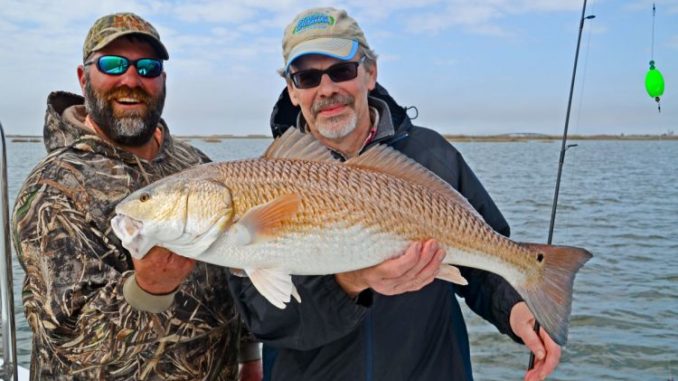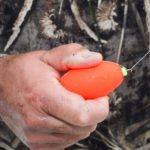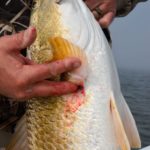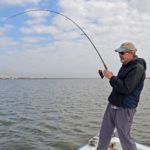
While most Louisiana anglers turn their noses up at bull reds, this guide says they offer great winter action. And a New Orleans chef knows they make excellent table fare — if prepared correctly.
When the guide slid the landing net under the fish, the chef’s face lit up like a Hollywood marquee.
Was it a tender-fleshed and delectable speckled trout? No.
Was it a savory, mild-tasting red snapper. No.
It wasn’t a flounder, tripletail or grouper, either.
It was a redfish. Of all things, a bull red — one with shoulders on it. The kind most fisherman call “too big to eat, too tough, too strong.”
Yet there was famed New Orleans seafood chef Tenney Flynn, twice named Chef of the Year by New Orleans magazine and the partnering owner of GW Fins (likely the most seafood-oriented fine-dining restaurant in a city known for both unmatched restaurants and great seafood), smiling at his prize.
Flynn does all the buying and recipe development for the restaurant. He gets to pick from the best fish available.
And there he was, drooling over a bull redfish.
Why?
“Almost any fish is good to eat if it is fresh and properly prepared,” was Flynn’s answer.
The two men were fishing out of Empire, home turf for charter Capt. Lloyd Landry IV (Outcast Fishing Charters, 504-912-8291).
They couldn’t have appeared more unlike.
Landry was a burly bear of a man with a big, dark beard and a heavy tan. Always cheerful and outgoing, what you see is what you get.
Also bearded, but with an intellectual-looking goatee, Flynn was slender and more slightly built, with a wan, yet healthy complexion. At first, he seemed reticent to talk, but when he warmed to a subject, he parsed it at length, displaying a dry, mischievous humor.
Missing from the trip was the guy who put it together, C. T. Williams III, host of Bigfish television fishing show, who called in sick at the last minute. Landry often takes Williams on fishing excursions for the show and Flynn does a cooking segment for the show.
It was mid-winter and the weather kind of stunk — cold, yet damp and foggy, in spite of the sun’s attempts to penetrate the fog from above.
Any self-respecting speckled trout fisherman would have been hanging around the house. Specks don’t bite in this kind of weather — but bull redfish do.
“As a state, local anglers are completely obsessed with speckled trout,” Landry growled. “In the years I have been guiding, I have been focused on finding speckled trout for customers. I don’t know 100 percent why, but I have so many people who say, ‘Oh, we don’t want redfish.’
“Speckled trout can be finicky at some times of the year and hard to catch. Winter trout fishing is very hard. We talk about this all the time. ‘Where do they go?’ After we get real cold fronts, trout disappear. Then in March or April, we get good tides and they appear.”
Reds offer the perfect alternative.
“A lot of people could go out and catch enough redfish for dinner,” Landry said. “And they could get 10 times more fight out of a redfish than a trout. But instead, they go pound their old trout spots for nothing, or they park their boats.
“The marinas are dead in the winter.”
As for bull reds, Landry said it’s a matter of perspective.
“Local people complain about them — look at them as trash fish,” he said. “Out-of-town clients: Holy cow, if they can catch a couple of them, I’m on a pedestal as a guide.”
Flynn agreed with Landry on the merits of bull redfish.
“I was sous chef at a highly regarded restaurant during the blackened redfish craze,” Flynn said.” We bought bull reds for 90 cents a pound, and they were fine. I would serve bull reds now (at his restaurant) if they were legal to harvest and sell.
“Some people say they are a little chewy. So what? Beef and veal both come from cattle. Beef is a little chewy. That’s not bad. They are just different.”
He said the local fascination with trout doesn’t extend to other regions of the country.
“If you get a couple hundred miles away from New Orleans, speckled trout is not that highly regarded,” Flynn said.
Flynn works five 11-hour days a week in the restaurant, but he fishes every chance he gets.
“I enjoy fishing,” he said. “I enjoy spearfishing and scuba diving’ I eat what I spear. It’s fun to swim around in the fish population.”
The slender chef was certainly enjoying the fishing provided by Landry this morning.
Like Flynn, Landry was interested in producing the highest quality eating fish possible. He jabbed the longest finger of one hand through the soft spot in the body located behind the pectoral fin of the fish to be kept. Once the finger was inserted, he wiggled deeply and vigorously to rupture blood vessels and bleed the fish inside.
After icing their limit of bull reds, the pair continued to catch and release fish.
Landry explained his tactics, while Flynn cranked in more bulls.
“Smaller reds hold tighter to shorelines. Bigger redfish are found farther off the banks,” Landry said. “I like to focus on (marsh) points. Where points are now, there is structure on the bottom farther out, where the old point used to be.”
That structure provides a current break that isn’t noticeable on the surface but attract baitfish, which in turn attract redfish.
“Look for points with water current and baitfish movement,” Landry recommended.
Bull redfish, he explained, are also found nearer the coast, or the remnants of the highly eroded coast. There, Landry likes to target shell points off each side of what islands remain.
Rock jetties are particularly productive, he added.
One of the attractive parts of fishing for redfish, particularly bull reds, is the simplicity of tackle needed.
Three-inch Gulp tails on unpainted jigheads are his bread and butter. Favorites are the shrimp or swimming mullet tails in chartreuse or glow and chartreuse.
The lures were fished under oval clip-on corks, which he likes because they can be quickly snapped on and off. Landry wrapped the line three times around the stem of the clip on both the top and bottom of the cork to keep it from sliding on the line.
As a final tip, Landry recommended bringing a pound of dead shrimp on any winter trip: If the water is dirty or even a little milky, he will tip his hook with a piece of shrimp.




